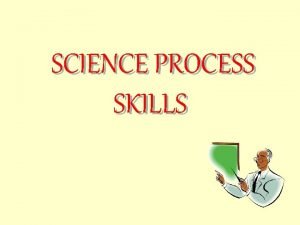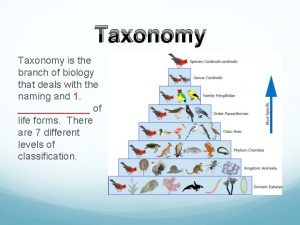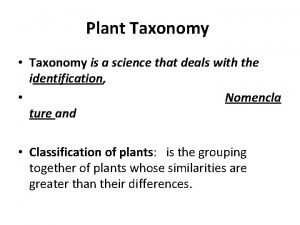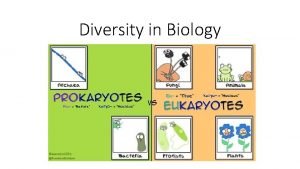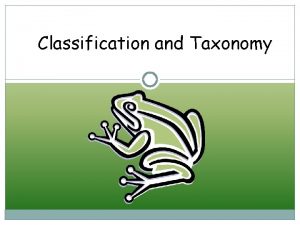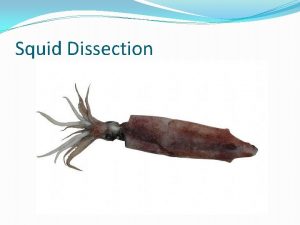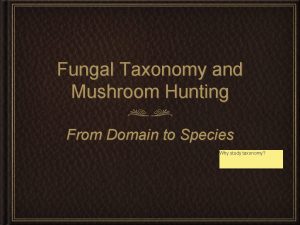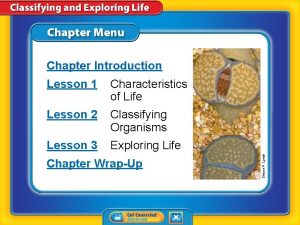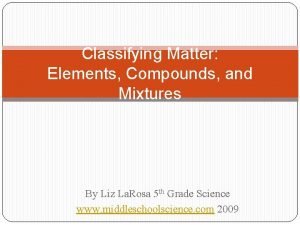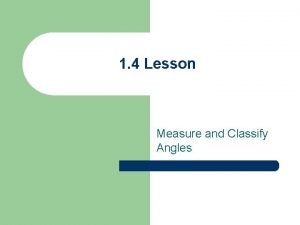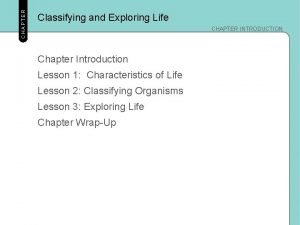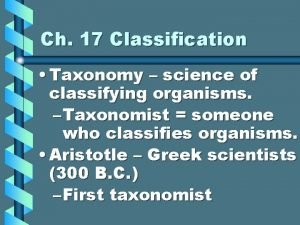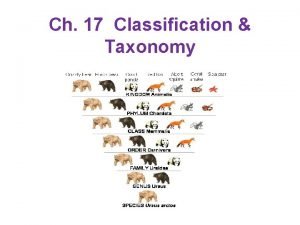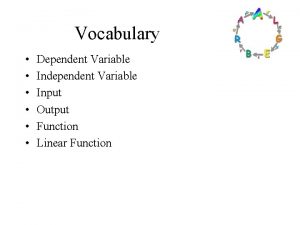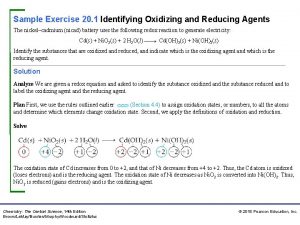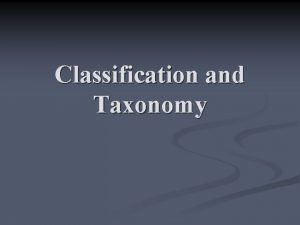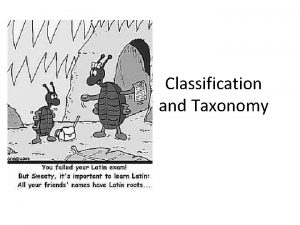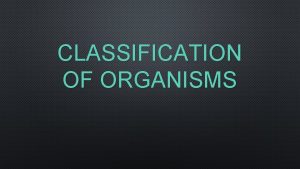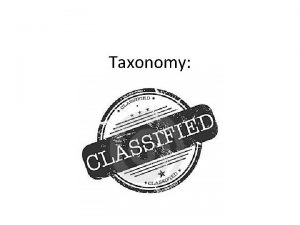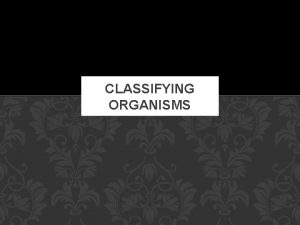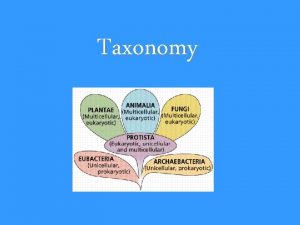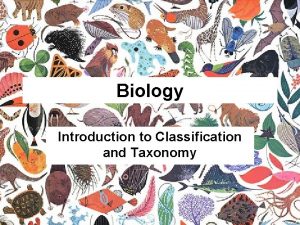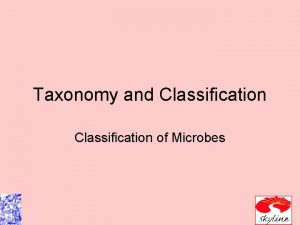Taxonomy Classification Taxonomy science of identifying and classifying


































































- Slides: 66

Taxonomy & Classification Taxonomy- science of identifying and classifying organisms; all about the naming Classification- systematic grouping and naming of organisms based on shared similarities

Pub. Med Search on 9/13/09 “tree of life” AND 2009 59 articles so far this year

Why classify?

“Planet Bob” http: //www. planetbob. asu. edu

Among the Top 10 New Organisms of 2008 (wired. com) smallest snake found in Barbados 120, 000 y. o. glacier bacteria alive mother of all living ants- pale, eyeless, subterranean new giant clam species found in Red Sea new catfish found in Venezuela/Colombia nematode turns ant abdomen into fruit mimic to spread eggs new songbird found in Gabon

How to classify?

Taxonomy & Classification Taxonomy- science of identifying and classifying organisms; all about the naming Classification- systematic grouping and naming of organisms based on shared similarities Systematics- branch of biology that seeks to classify biodiversity using everything known about an organism in order to understand its evolutionary relationship to other organisms

A Brief History of Classification

4 th century B. C. The Age of Aristotle • No modern technology • How to classify living organisms?

4 th century B. C. The Age of Aristotle • • No modern technology 2 main “Divisions” Plants (immobile) edible vs. inedible Animals (mobile) blood vs. bloodless walking vs. flying vs. swimming In use for over 2000 years (through 1600 s A. D. ) • • •

• • 1500 s to 1600 s: The Age of Exploration Extensive travel to New World Hudson lands in NY 400 yrs. ago Collect & classify as many specimens as possible Many newly discovered organisms “Folk taxonomy” is the rule “free for all” long descriptive names one organism given multiple names multiple organisms given same name • • •

• • Folk Taxonomy Solanum caule inermi herbaceo, foliis pinnatis incisis, racemis simplicibus Translation: solanum with a smooth herbaceous stem, incised pinnate leaves and simple inflorescence • pill bug, sow’s ear, roly poly, sowbug

1700 s: The Age of Carolus Linnaeus (born Carl Linne in Sweden) • Physician, botanist, zoologist • Father of Modern Biological Classification” • Standardized classification • Originated binomial nomenclature • Genus species • Established hierarchical naming • Broad to specific • Kingdom, Phylum, Class, Order, Family, Genus, Species

1700 s: The Age of Carolus Linnaeus • Classification system based on phenetics • shared physical or other observable characteristics • (does not take into account evolutionary history, fossils, embryology, behavior) How might phenetics mislead us in classifying organisms?

Phenetics may mislead. . . • legless lizards & snakes • bats & birds vs. bats & cats

1700 s: The Age of Carolus Linnaeus • Standardized naming solves “folk taxonomy” problem • Provides common language • one name - one organism • Solanum lycopersicum • Armadillium vulgare How would Linnaeus have divided organisms into Kingdoms?

1700 s: The Age of Carolus Linnaeus • Linnaeus’ 2 Kingdoms (1735) • Plantae • Animalia

1700 s-1800 s: The Age of Microscopy • Great advances in microscopes How will this affect our system of classification?

1700 s-1800 s: The Age of Microscopy Based on what is known at the time, how would you classify these?

1700 s-1800 s: The Age of Microscopy • Ernst Haeckel adds 3 rd Kingdom (1866) • Protista (all single-celled organisms) • Plantae • Animalia

1800 s: The Age of Darwin • Charles Darwin publishes On the Origins of Species How will this influence our system of classification?

1800 s: The Age of Darwin • Charles Darwin publishes On the Origins of Species • Classification must reflect common descent • Introduces concept of & coins term “Tree of Life” • Ernest Haeckel coins term phylogeny • Classification based on evolutionary

Darwin’s “Tree of Life” On the Origins of Species, 1859

Ernest Haeckel’s Pedigree of Man, 1879

1950 s-60 s: Move from 3 to 4 to 5 Kingdoms 4 Kingdoms based on phenetics* • Monera (single-celled prokaryotes) • Protista (single-celled eukaryotes) • Plantae (autotrophic, multicellular eukaryotes) • Animalia (heterotrophic, multicellular eukaryotes) (Herbert Copeland, 1956)

1950 s-60 s: Move from 3 to 4 to 5 Kingdoms based on phenetics • Monera • Protista • Plantae • Fungi (absorptive heterotrophs, eukaryotes, mostly multicellular) • Animalia (Robert Whittaker, 1969)

Mid 1900 s: The Cladistic Challenge Begins • Systematics- branch of biology that seeks to classify biodiversity using everything known about an organism in order to understand its evolutionary relationship to other organisms • Cladistic analysis- form hypotheses about evolutionary relationships (cladograms and phylogenetic trees) and test by looking for evidence to support or refute, also called phylogenetic systematics • Clade- group of organisms that share common characteristics and a common ancestor

• Mid 1900 s: The Cladistic Challenge Begins Cladistic analysis (phylogenetic systematics) use cladograms (phylogenetic trees) to represent hypotheses about evolutionary relationships rely on all available data (morphological, molecular, biochemical, fossil, behavioral, embryology, etc. ) test hypotheses constant need to reorganize trees to be consistent with new evidence • •

Mid 1900 s: The Cladistic Challenge Begins Example: Cladogram of Reptiles

“Cladists” recognize only monophyletic groups.

Mid-late 1900 s: The Molecular Age • DNA and protein sequencing • Comparison of sequences among organisms • Major tool in cladistic analysis • Molecular evolution • Molecular clocks cytochrome c protein sequence alignment

Mid-late 1900 s: The Molecular Age • Kingdom Archaea is added • at 1 st called archaeabacteria • based on r. RNA sequence analysis • share features with both eukaryotes & prokaryotes Now there are 6 Kingdoms - Carl Woese, 1977 • Archaea • Eubacteria • Protista • Plantae • Fungi • Animalia

Mid-late 1900 s: The Molecular Age Kingdoms placed into 3 Domains (Carl Woese, 1990) Bacteria Eukarya Archeae 3 Domains • Bacteria • Archaea • Eukarya common ancestor (cenancestor or LUCA)

3 Domains from a Common Ancestor (Woese, 1977) Bacteria Eukarya Archeae Domains based on: • DNA sequence • genome organization • biochemical evidence • cellular characteristics • etc. common ancestor (cenancestor or LUCA) common ancestor referred to as cenancestor or LUCA (last universal common ancestor)

How is cladistics different from older systems of classification?

CLASSIFICATION: Traditional (phenetics) (structural data) vs. Phylogenetics (cladistics) (all data: structural, fossil, biochemical, molecular, etc. )

Homologous vs. Analogous Structures

Homologous vs. Analogous Structures Homologous • similar structures arose from common ancestor • divergent evolution Analogous • similar structures did not arise from common ancestor • convergent evolution • can lead to misinterpretations of evolutionary relationships

How is the fossil record useful in cladistic analysis?

How is the fossil record useful in cladistic analysis? • sequence in which fossils appear in strata says something about timing of existence of organism • can reveal ancestral relationships that may have been lost over time

Mid-late 1900 s: The Molecular Age • Move from 5 to 8 Kingdoms • Protista further subdivided; many members more like plants or animals than they are each other 8 Kingdoms (by some accounts) • Archaea • Eubacteria • Archaezoa • Protista • Chromista • Plantae • Fungi • Animalia Based on evolutionary relatonships and molecular genetics


(Woese et al. , 1990) Domains (3) Archaea Bacteria Eukarya

2000 & on: Age of Phylogenomic http: //genomesonline. org • Whole genomes being sequenced at rapid rate • comparisons reveal new evolutionary relationships • evidence for horizontal gene transfer • evidence that eukaryotes arose from fusion of archaea with bacteria

Hypothesis: Endosymbiotic events resulted in new species Symbiosis -close and often longterm ecological relationships between 2 organisms Endosymbiosis -one organism lives within the cells or tissues of another An example of endosymbiosis w/o formation of new species (so far) is bacteria inside protist inside termite gut. Bacteria helps protist move and get food and helps termite by digesting cellulose.

2000 & on: Age of Phylogenomics • Is it a “Tree of Life” or Ring of Life”? ? ? • Cladistic analysis continues

• Tree of Life Web Project (To. L) • Seeks to create “super tree” • Thus far based on DNA sequence data from 3000 species • Circle is best viewed at 1. 5 meter diameter (David Hillis)

Phylogenetic systematics (cladistics) is not set in stone!!! • It is a HYPOTHESIS!!! • trees vs. rings of life? ? ? • How many Kingdoms? ? ? • even the experts disagree • in this class, we will go with 8 • Phyla are constantly being reshuffled • Different sources of evidence lead to competing interpretations • New data becoming available all the time • Hypotheses constantly revised accordingly

8 Kingdoms grouped into 3 Domains

8 Kingdoms 1. Archaebacteria 2. Eubacteria 3 Domains “commonly” Archaea Bacteria “bacteria” prokaryotes (no nucleus) Eukarya eukaryotes (true nucleus) 3. Archaezoa 4. Protista 5. Chromista 6. Plantae 7. Fungi 8. Animalia

8 Kingdoms Archaebacteria- prokaryotes, unicellular (mostly), tend to be extremophiles Eubacteria- prokaryotes, unicellular (mostly) Archaezoa- unicellular eukaryotes, no mitochondria, peroxisomes or Golgi apparatus Protista- simple, mostly unicellular eukaryotes, no tissues Chromista- unicellular eukaryotes, brown algae, diatoms Plantae- multicellular eukaryotes, cell walls, tissues, autotrophs Fungi- mostly unicellular eukaryotes, chitin in cell wall, absorptive heterotrophs Animalia- multicellular eukaryotes, tissues, no cell walls, heterotrophs


3 Domains: The Summary Table

Nuclear envelope • membrane surrounding nucleus; encloses genetic material; only eukarya have “true” or membrane-bound nucleus absent (prokaryotic) present (eukaryotes)

Membrane-bound organelles • intracellular structures enclosed within a lipid membrane • ex. chloroplasts, mitochondria, endoplasmic reticulum, Golgi apparatus, vacuole, nucleus absent (prokaryotic) present (eukaryotes) came about by infolding of the plasma membrane or endosymbiosis

Peptidoglycan in cell wall • cell wall surrounds cell membrane, provides structural support • peptidoglycan is a large polymer of sugars and amino acids, forms mesh-like structure that gives rigidity to cell wall present absent

Membrane lipids • fats in the cellular membranes that provide fluidity and/or rigidity ester-linked ether-linked ester-linked unbranched hydrocarbons some branched hydrocarbons unbranched hydrocarbons

Plasmids • extra-chromosomal piece of DNA found in cell; often contains antibiotic resistance genes yes no

Circular chromosome present not enclosed in any structure by located near plasma membrane absent multiple linear chromosomes located in nucleus

RNA polymerase • enzyme that copies DNA to RNA one kind several kinds 3 different kinds

Initiation amino acids for start of protein synthesis • formyl-methionine (f-Met) vs. just plain methionine (Met) as the first amino acid added to a protein f-MET MET

Ribosomes • 2 subunits, one large and one small • made of r. RNA and protein • site of protein synthesis • size is in “sedimentation rate”, abbreviated “s” for Svedberg unit 70 s grouped in long chains called polyribosomes, 30 s + 50 s subunits make up 70 s 80 s

Introns • non-coding sequence in genes • large hn. RNA made first that must be spliced (cut out introns) into m. RNA and then protein is translated from m. RNA rare/absent present in some genes present in all genes

Operons • ordered arrangement of genes within the DNA; arranged by function • ex. all genes involved in lactose utilization (a sugar used as food) are in a single operon and transcribed as a single m. RNA Present Not present

Sensitivity to antibiotics/toxins • chloramphenicol- inhibits ribosomal function affecting protein synthesis • streptomycin- interferes with f-MET binding to r. RNA and ribosomes, affects protein synthesis • dipthteria toxin- interferes with ribosomal function chloramphenicol and streptomycin: growth inhibited chloramphenicol and streptomycin: growth NOT inhibited diphtheria toxin: growth inhibited

Histones • proteins that are used to compact/package the chromosomal DNA Not present Present in some species Present
 Identifying and non identifying adjective clauses
Identifying and non identifying adjective clauses How to identify clauses
How to identify clauses Identifying and non identifying adjective clauses
Identifying and non identifying adjective clauses Kendall and marzano's new taxonomy
Kendall and marzano's new taxonomy Genus order family
Genus order family Canis latrans classification
Canis latrans classification What's your favourite school
What's your favourite school Observing in science process skills
Observing in science process skills Science process skills definition
Science process skills definition Sunflower classification
Sunflower classification Biodiversity examples
Biodiversity examples Dichotomous key of animals
Dichotomous key of animals Taxonomy is the branch of science that deals with –
Taxonomy is the branch of science that deals with – Are coelenterates warm or cold blooded
Are coelenterates warm or cold blooded King philip coughed on fred
King philip coughed on fred Loculicidal capsule fruit
Loculicidal capsule fruit Crayfish taxonomy
Crayfish taxonomy How to write scientific names
How to write scientific names Horse phylum
Horse phylum Squid taxonomy
Squid taxonomy Mushroom taxonomy classification
Mushroom taxonomy classification Anthropology vs sociology
Anthropology vs sociology Science fusion introduction to science and technology
Science fusion introduction to science and technology Hard science and soft science
Hard science and soft science Characteristic of quadrilateral
Characteristic of quadrilateral Non rational numbers
Non rational numbers Name the polynomial
Name the polynomial Integers rational numbers and whole numbers
Integers rational numbers and whole numbers Measuring and classifying angles
Measuring and classifying angles 4-1 classifying triangles
4-1 classifying triangles Classifying and exploring life
Classifying and exploring life Classifying elements compounds and mixtures
Classifying elements compounds and mixtures How to classify an angle
How to classify an angle The process of classifying and reviewing past due accounts
The process of classifying and reviewing past due accounts Comparing and classifying
Comparing and classifying Classifying and exploring life lesson 2 answers
Classifying and exploring life lesson 2 answers Classifying and exploring life
Classifying and exploring life Fungi cell
Fungi cell Discipline of classifying and naming organisms
Discipline of classifying and naming organisms Exploring and classifying life
Exploring and classifying life Discipline of classifying and naming organisms
Discipline of classifying and naming organisms Liger taxonomy
Liger taxonomy Classification of data in statistics
Classification of data in statistics Independent vs dependent variable
Independent vs dependent variable Mood n tone
Mood n tone Style and tone in writing
Style and tone in writing Identify oxidizing and reducing agents practice
Identify oxidizing and reducing agents practice Recognizing parallel structure
Recognizing parallel structure Mis bidgoli
Mis bidgoli Identify and representing functions
Identify and representing functions Identifying the inquiry and stating the problem
Identifying the inquiry and stating the problem What is a dependent variable in math
What is a dependent variable in math Identifying complete sentences
Identifying complete sentences Gerund and gerund phrases
Gerund and gerund phrases Identifying market segments and targets chapter 9
Identifying market segments and targets chapter 9 Identifying market segments and targets chapter 9
Identifying market segments and targets chapter 9 Potential development projects can be identified by:
Potential development projects can be identified by: Identifying even and odd functions
Identifying even and odd functions Identifying percentage rate and base
Identifying percentage rate and base Compounds and mixtures worksheet
Compounds and mixtures worksheet Identifying tone and style
Identifying tone and style Analysis style and tone
Analysis style and tone Independent clause
Independent clause Identifying similarities and differences
Identifying similarities and differences Identifying and managing project risk tom kendrick
Identifying and managing project risk tom kendrick Identifying market segments and targets chapter 9
Identifying market segments and targets chapter 9 Recruitment is the process of locating identifying and
Recruitment is the process of locating identifying and








